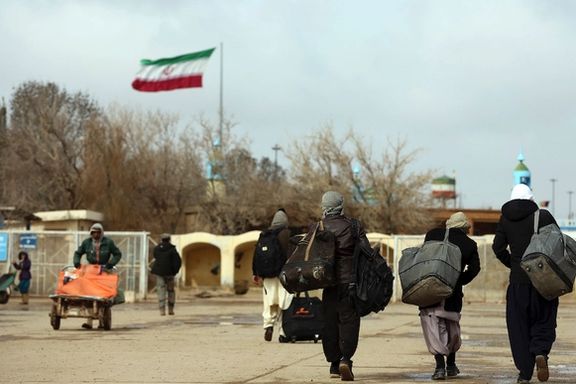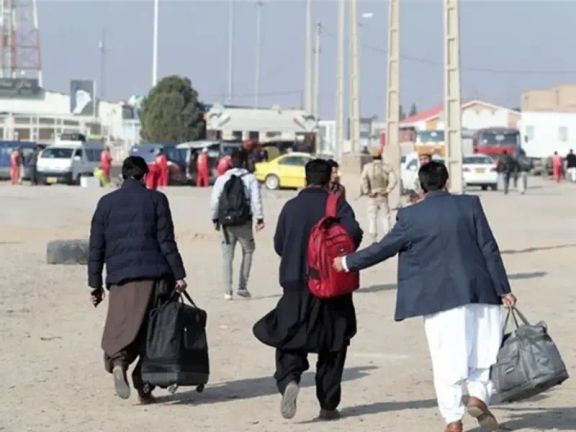Iran’s smart card scheme exploits Afghan migrants amid deportations

As Iran's government claims to be deporting more Afghan migrants, new details have emerged about a plan to charge large sums from those trying to remain in the country.

As Iran's government claims to be deporting more Afghan migrants, new details have emerged about a plan to charge large sums from those trying to remain in the country.
A recent report from the Tehran-based pro-reform newspaper Ham-Mihan revealed that Afghans must now purchase an expensive smart card to stay in Iran—a card that costs one billion rials (nearly $1,700).
This requirement comes at a time when Afghan immigration has surged, with estimates suggesting that up to 10,000 Afghans enter Iran daily, swelling the Afghan population in the country to as high as 10 million, or more than 10% of the population.
A backlash against Afghans has intensified on social media, with many Iranians complaining about the economic and social cost of hosting so many migrants amid Iran's own economic crisis, dwindling public services and joblessness.
Ham-Mihan quoted Arefeh, an Afghan woman who moved to Iran six years ago with her husband, describing the ordeal they faced when attempting to renew their Afghan passports. "We were told we needed to purchase a smart card to stay in Iran," Arefeh recounted. "The smart card, however, costs one billion rials." This card is now mandatory for the head of the family and any male child over 18 to remain and work in Iran. According to the report, authorities no longer accept census papers, passports, or residency cards, making the smart card the only option for legal residency.

This policy, adopted in June of last year, is widely seen as a money-making scheme by the Iranian government. Issued by the Ministry of Foreign Affairs through the Bureau for Aliens and Foreign Immigrants Affairs, the smart cards have become part of what some are calling the "One billion rial investment plan," a label that underscores the financial burden on Afghan migrants. With millions of Afghans in the country, if the government collects this fee solely from the head of each family, Iran stands to rake in billions of dollars through this scheme, exploiting one of the world's most vulnerable populations for financial gain.
The timing of this new policy coincides with a marked increase in the deportation of Afghan migrants, which has intensified this summer. In mid-August, the governor of Shahriar County in Tehran Province announced a "swift operation to round up illegal migrants," targeting undocumented Afghans. Local official Alireza Fatehi-Nejad emphasized the challenges posed by undocumented Afghans, citing legal issues and the strain on public resources.

This operation, coordinated by multiple government agencies, has led to the forced repatriation of many Afghans. However, reports indicate that despite being deported, many Afghans return to Iran due to the dire conditions in Afghanistan and the fact that their families remain in the country. This cycle of deportation and return highlights the persistent challenges Afghan migrants face in Iran.
Eskandar Momeni, Iran’s new Interior Minister, said Monday that “One of my main priorities… is the issue of foreign nationals. We will present a bill for the establishment of the National Migration Organization to the Parliament…, and we will begin the work.”
In response to a question regarding the Border Guard Commander announcing that undocumented foreign nationals must leave Iran by March 2025, Momeni said “This matter is also in progress, and we are following up on it.”
The situation has sparked outrage among activists and intellectuals within Iran. In October, over 540 artists, lawyers, doctors, journalists, and civil society activists called for an end to the "mistreatment" of Afghan migrants. The deportation of over 20,000 Afghan children, many of whom were unaccompanied, has further fueled criticism.
There are no precise figures on the number of Afghans living in Iran, but estimates range between 5 to 8 million, with some suggesting the number could be as high as 15 million, raising questions about the government's motives. Critics accuse the Islamic Republic of pursuing an "open border" policy, allowing thousands of Afghans to enter illegally each day. This influx has led to widespread speculation about the government's hidden agenda.
Many Iranians believe the Islamic Republic actively encourages mass Afghan migration for several reasons. Some argue that as a large segment of the population has distanced itself from religion, the authorities are trying to alter the country's demographic makeup, so that the clerical rulers can tighten their grip on power.
A user on X shared a photo of Afghans climbing over a wall at the Iranian border, commenting that despite spending three billion euros on building and completing this wall to stop Afghan entry, the border closure now feels like a joke.
Others suggest that the government views the Afghan population as a strategic asset. Supreme Leader Ali Khamenei has long sought to increase the population in line with Shia ideology, but economic hardships and lifestyle choices have led many Iranians to forgo having large families. In this context, the presence of Afghans serves Khamenei's goal of population growth.
Moreover, Afghans, often desperate for work, are seen as prime recruits for the IRGC’s overseas operations in Syria and Lebanon. By fostering resentment towards Afghan migrants, the government deflects public anger away from itself and towards a scapegoat, further entrenching its power.